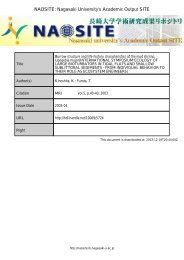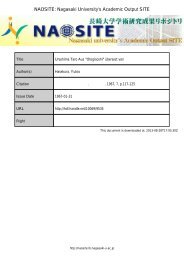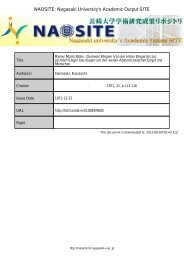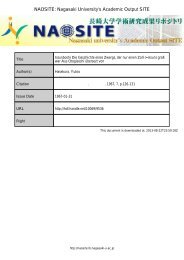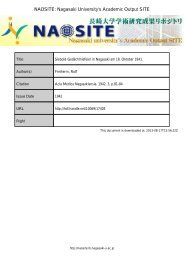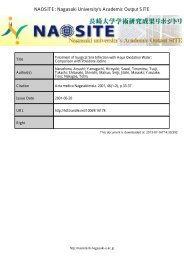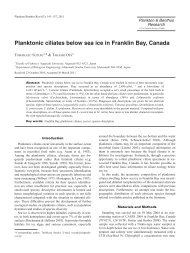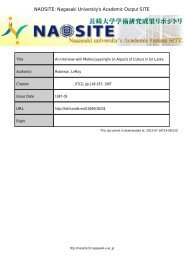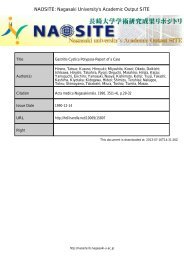本文ファイル
本文ファイル
本文ファイル
You also want an ePaper? Increase the reach of your titles
YUMPU automatically turns print PDFs into web optimized ePapers that Google loves.
NAOSITE: Nagasaki University's Ac<br />
Title<br />
Melosira moniliformisの 有 性 生 殖<br />
Author(s)<br />
右 田 , 清 治<br />
Citation 長 崎 大 学 水 産 学 部 研 究 報 告 , v.23, pp.123-133; 196<br />
Issue Date 1967-08<br />
URL<br />
http://hdl.handle.net/10069/31384<br />
Right<br />
This document is downloaded<br />
http://naosite.lb.nagasaki-u.ac.jp
Melosira moniliformis <br />
<br />
Sexual Reproduction of Melosira moniliforrnis AGARDH<br />
Seiji MIGITA<br />
The auxospores of centric diatoms had long been thought to be formed<br />
asexually. In recent years, our knowledge of the sexual reproduction<br />
and life history of the diatoms has been greatly advanced. Accordingly,<br />
STOSCH1 ) demonstrated auxospore formation by oogamy in Melosira<br />
varians, and then STOSCH2-5) and DREBES6•7) studied sexual reproduction<br />
in several species of Centrales.<br />
In the present report, the author studied on the morphology and ecology<br />
of sexual reproduction of Melosira moniliforrnis AGARDH, using materials<br />
collected from the mouth area of the Hachiro River near Nagasaki.<br />
Some physical factors affecting gametogenesis of this alga, such as temperature,<br />
light intensity and chlorinity, were also studied experimentally.<br />
The results obtained are summarized as follows :<br />
The formation of spermatogonia and oogonia was observed on narrow<br />
clones, ranging between 7µ and 20µ in diameter. The male cell, after<br />
one or two mitotic cell divisions, forms two or four spermatogonia, and<br />
then produces four spermatozoa in each spermatogonium.<br />
The spermatozoa are globular or ovate in shape, being 10-12µ long<br />
and 5 - 8µ wide, poor in plastids, and they each possess one flagellum of<br />
about 18µ. The spermatozoa leave behind much of the cystoplasm and<br />
the plastids at the time of swimming.<br />
The oogonia are developed directly from vegetative cells, accompanied<br />
by elongation of the cell and multiplication of plastids. One egg cell is<br />
formed in each oogonium. After fertilization, a zygote develops into an<br />
auxospore. Fully grown auxospores are enlarged 2.3 times the mother<br />
cells in mean diameter.<br />
This alga is monoecious, one clone producing male and female gametes,<br />
like all centric diatoms hitherto studied.<br />
The sexuality seems to be intimately connected with the phenomenon<br />
of cell size decrease in this species. The suitable size for producing<br />
male and female cells is shown in Fig. 4 .<br />
In reference to physical factors affecting sexual reproduction, temperature<br />
levels between 15° and 20°C were proved to be most effective. Especially,<br />
light intensity influenced on sex determination; female cells were<br />
mostly produced under strong light, whilst male cells were produced under<br />
weak light.
Melosira moniliformis <br />
<br />
Sexual Reproduction of Melosira moniliforrnis AGARDH<br />
Seiji MIGITA<br />
The auxospores of centric diatoms had long been thought to be formed<br />
asexually. In recent years, our knowledge of the sexual reproduction<br />
and life history of the diatoms has been greatly advanced. Accordingly,<br />
STOSCH1 ) demonstrated auxospore formation by oogamy in Melosira<br />
varians, and then STOSCH2-5) and DREBES6•7) studied sexual reproduction<br />
in several species of Centrales.<br />
In the present report, the author studied on the morphology and ecology<br />
of sexual reproduction of Melosira moniliforrnis AGARDH, using materials<br />
collected from the mouth area of the Hachiro River near Nagasaki.<br />
Some physical factors affecting gametogenesis of this alga, such as temperature,<br />
light intensity and chlorinity, were also studied experimentally.<br />
The results obtained are summarized as follows :<br />
The formation of spermatogonia and oogonia was observed on narrow<br />
clones, ranging between 7µ and 20µ in diameter. The male cell, after<br />
one or two mitotic cell divisions, forms two or four spermatogonia, and<br />
then produces four spermatozoa in each spermatogonium.<br />
The spermatozoa are globular or ovate in shape, being 10-12µ long<br />
and 5 - 8µ wide, poor in plastids, and they each possess one flagellum of<br />
about 18µ. The spermatozoa leave behind much of the cystoplasm and<br />
the plastids at the time of swimming.<br />
The oogonia are developed directly from vegetative cells, accompanied<br />
by elongation of the cell and multiplication of plastids. One egg cell is<br />
formed in each oogonium. After fertilization, a zygote develops into an<br />
auxospore. Fully grown auxospores are enlarged 2.3 times the mother<br />
cells in mean diameter.<br />
This alga is monoecious, one clone producing male and female gametes,<br />
like all centric diatoms hitherto studied.<br />
The sexuality seems to be intimately connected with the phenomenon<br />
of cell size decrease in this species. The suitable size for producing<br />
male and female cells is shown in Fig. 4 .<br />
In reference to physical factors affecting sexual reproduction, temperature<br />
levels between 15° and 20°C were proved to be most effective. Especially,<br />
light intensity influenced on sex determination; female cells were<br />
mostly produced under strong light, whilst male cells were produced under<br />
weak light.
Melosira moniliformis <br />
<br />
Sexual Reproduction of Melosira moniliforrnis AGARDH<br />
Seiji MIGITA<br />
The auxospores of centric diatoms had long been thought to be formed<br />
asexually. In recent years, our knowledge of the sexual reproduction<br />
and life history of the diatoms has been greatly advanced. Accordingly,<br />
STOSCH1 ) demonstrated auxospore formation by oogamy in Melosira<br />
varians, and then STOSCH2-5) and DREBES6•7) studied sexual reproduction<br />
in several species of Centrales.<br />
In the present report, the author studied on the morphology and ecology<br />
of sexual reproduction of Melosira moniliforrnis AGARDH, using materials<br />
collected from the mouth area of the Hachiro River near Nagasaki.<br />
Some physical factors affecting gametogenesis of this alga, such as temperature,<br />
light intensity and chlorinity, were also studied experimentally.<br />
The results obtained are summarized as follows :<br />
The formation of spermatogonia and oogonia was observed on narrow<br />
clones, ranging between 7µ and 20µ in diameter. The male cell, after<br />
one or two mitotic cell divisions, forms two or four spermatogonia, and<br />
then produces four spermatozoa in each spermatogonium.<br />
The spermatozoa are globular or ovate in shape, being 10-12µ long<br />
and 5 - 8µ wide, poor in plastids, and they each possess one flagellum of<br />
about 18µ. The spermatozoa leave behind much of the cystoplasm and<br />
the plastids at the time of swimming.<br />
The oogonia are developed directly from vegetative cells, accompanied<br />
by elongation of the cell and multiplication of plastids. One egg cell is<br />
formed in each oogonium. After fertilization, a zygote develops into an<br />
auxospore. Fully grown auxospores are enlarged 2.3 times the mother<br />
cells in mean diameter.<br />
This alga is monoecious, one clone producing male and female gametes,<br />
like all centric diatoms hitherto studied.<br />
The sexuality seems to be intimately connected with the phenomenon<br />
of cell size decrease in this species. The suitable size for producing<br />
male and female cells is shown in Fig. 4 .<br />
In reference to physical factors affecting sexual reproduction, temperature<br />
levels between 15° and 20°C were proved to be most effective. Especially,<br />
light intensity influenced on sex determination; female cells were<br />
mostly produced under strong light, whilst male cells were produced under<br />
weak light.
Melosira moniliformis <br />
<br />
Sexual Reproduction of Melosira moniliforrnis AGARDH<br />
Seiji MIGITA<br />
The auxospores of centric diatoms had long been thought to be formed<br />
asexually. In recent years, our knowledge of the sexual reproduction<br />
and life history of the diatoms has been greatly advanced. Accordingly,<br />
STOSCH1 ) demonstrated auxospore formation by oogamy in Melosira<br />
varians, and then STOSCH2-5) and DREBES6•7) studied sexual reproduction<br />
in several species of Centrales.<br />
In the present report, the author studied on the morphology and ecology<br />
of sexual reproduction of Melosira moniliforrnis AGARDH, using materials<br />
collected from the mouth area of the Hachiro River near Nagasaki.<br />
Some physical factors affecting gametogenesis of this alga, such as temperature,<br />
light intensity and chlorinity, were also studied experimentally.<br />
The results obtained are summarized as follows :<br />
The formation of spermatogonia and oogonia was observed on narrow<br />
clones, ranging between 7µ and 20µ in diameter. The male cell, after<br />
one or two mitotic cell divisions, forms two or four spermatogonia, and<br />
then produces four spermatozoa in each spermatogonium.<br />
The spermatozoa are globular or ovate in shape, being 10-12µ long<br />
and 5 - 8µ wide, poor in plastids, and they each possess one flagellum of<br />
about 18µ. The spermatozoa leave behind much of the cystoplasm and<br />
the plastids at the time of swimming.<br />
The oogonia are developed directly from vegetative cells, accompanied<br />
by elongation of the cell and multiplication of plastids. One egg cell is<br />
formed in each oogonium. After fertilization, a zygote develops into an<br />
auxospore. Fully grown auxospores are enlarged 2.3 times the mother<br />
cells in mean diameter.<br />
This alga is monoecious, one clone producing male and female gametes,<br />
like all centric diatoms hitherto studied.<br />
The sexuality seems to be intimately connected with the phenomenon<br />
of cell size decrease in this species. The suitable size for producing<br />
male and female cells is shown in Fig. 4 .<br />
In reference to physical factors affecting sexual reproduction, temperature<br />
levels between 15° and 20°C were proved to be most effective. Especially,<br />
light intensity influenced on sex determination; female cells were<br />
mostly produced under strong light, whilst male cells were produced under<br />
weak light.
Melosira moniliformis <br />
<br />
Sexual Reproduction of Melosira moniliforrnis AGARDH<br />
Seiji MIGITA<br />
The auxospores of centric diatoms had long been thought to be formed<br />
asexually. In recent years, our knowledge of the sexual reproduction<br />
and life history of the diatoms has been greatly advanced. Accordingly,<br />
STOSCH1 ) demonstrated auxospore formation by oogamy in Melosira<br />
varians, and then STOSCH2-5) and DREBES6•7) studied sexual reproduction<br />
in several species of Centrales.<br />
In the present report, the author studied on the morphology and ecology<br />
of sexual reproduction of Melosira moniliforrnis AGARDH, using materials<br />
collected from the mouth area of the Hachiro River near Nagasaki.<br />
Some physical factors affecting gametogenesis of this alga, such as temperature,<br />
light intensity and chlorinity, were also studied experimentally.<br />
The results obtained are summarized as follows :<br />
The formation of spermatogonia and oogonia was observed on narrow<br />
clones, ranging between 7µ and 20µ in diameter. The male cell, after<br />
one or two mitotic cell divisions, forms two or four spermatogonia, and<br />
then produces four spermatozoa in each spermatogonium.<br />
The spermatozoa are globular or ovate in shape, being 10-12µ long<br />
and 5 - 8µ wide, poor in plastids, and they each possess one flagellum of<br />
about 18µ. The spermatozoa leave behind much of the cystoplasm and<br />
the plastids at the time of swimming.<br />
The oogonia are developed directly from vegetative cells, accompanied<br />
by elongation of the cell and multiplication of plastids. One egg cell is<br />
formed in each oogonium. After fertilization, a zygote develops into an<br />
auxospore. Fully grown auxospores are enlarged 2.3 times the mother<br />
cells in mean diameter.<br />
This alga is monoecious, one clone producing male and female gametes,<br />
like all centric diatoms hitherto studied.<br />
The sexuality seems to be intimately connected with the phenomenon<br />
of cell size decrease in this species. The suitable size for producing<br />
male and female cells is shown in Fig. 4 .<br />
In reference to physical factors affecting sexual reproduction, temperature<br />
levels between 15° and 20°C were proved to be most effective. Especially,<br />
light intensity influenced on sex determination; female cells were<br />
mostly produced under strong light, whilst male cells were produced under<br />
weak light.
Melosira moniliformis <br />
<br />
Sexual Reproduction of Melosira moniliforrnis AGARDH<br />
Seiji MIGITA<br />
The auxospores of centric diatoms had long been thought to be formed<br />
asexually. In recent years, our knowledge of the sexual reproduction<br />
and life history of the diatoms has been greatly advanced. Accordingly,<br />
STOSCH1 ) demonstrated auxospore formation by oogamy in Melosira<br />
varians, and then STOSCH2-5) and DREBES6•7) studied sexual reproduction<br />
in several species of Centrales.<br />
In the present report, the author studied on the morphology and ecology<br />
of sexual reproduction of Melosira moniliforrnis AGARDH, using materials<br />
collected from the mouth area of the Hachiro River near Nagasaki.<br />
Some physical factors affecting gametogenesis of this alga, such as temperature,<br />
light intensity and chlorinity, were also studied experimentally.<br />
The results obtained are summarized as follows :<br />
The formation of spermatogonia and oogonia was observed on narrow<br />
clones, ranging between 7µ and 20µ in diameter. The male cell, after<br />
one or two mitotic cell divisions, forms two or four spermatogonia, and<br />
then produces four spermatozoa in each spermatogonium.<br />
The spermatozoa are globular or ovate in shape, being 10-12µ long<br />
and 5 - 8µ wide, poor in plastids, and they each possess one flagellum of<br />
about 18µ. The spermatozoa leave behind much of the cystoplasm and<br />
the plastids at the time of swimming.<br />
The oogonia are developed directly from vegetative cells, accompanied<br />
by elongation of the cell and multiplication of plastids. One egg cell is<br />
formed in each oogonium. After fertilization, a zygote develops into an<br />
auxospore. Fully grown auxospores are enlarged 2.3 times the mother<br />
cells in mean diameter.<br />
This alga is monoecious, one clone producing male and female gametes,<br />
like all centric diatoms hitherto studied.<br />
The sexuality seems to be intimately connected with the phenomenon<br />
of cell size decrease in this species. The suitable size for producing<br />
male and female cells is shown in Fig. 4 .<br />
In reference to physical factors affecting sexual reproduction, temperature<br />
levels between 15° and 20°C were proved to be most effective. Especially,<br />
light intensity influenced on sex determination; female cells were<br />
mostly produced under strong light, whilst male cells were produced under<br />
weak light.
Skeletonerna costatum8) <br />
<br />
<br />
<br />
<br />
M moniliformis <br />
<br />
STOSCH1) M varians, DREBES7 Stephanopyxis<br />
palmerzana <br />
<br />
<br />
<br />
<br />
<br />
<br />
<br />
<br />
M. monzlzformzs<br />
<br />
<br />
<br />
<br />
<br />
<br />
<br />
<br />
<br />
<br />
<br />
<br />
<br />
<br />
<br />
<br />
<br />
<br />
<br />
<br />
Lithodesmium sp.5) Skeletonema costatum8)<br />
<br />
<br />
<br />
<br />
STOSCH Stephanopyxis <br />
STOSCH2 ) Badul phza, Die ylum <br />
<br />
<br />
<br />
<br />
Meloszra monzlzformzs
Melosira moniliformis <br />
<br />
<br />
<br />
<br />
<br />
<br />
<br />
<br />
<br />
<br />
<br />
<br />
<br />
<br />
<br />
<br />
<br />
<br />
<br />
<br />
<br />
1 ) STOSCH, H. A. v. : Entwicklungsgeschichtliche Untersuchungen an zentrischen<br />
Diatomeen. 1. Die Auxosporenbildung von Melosira varians. Arch. Microbiol.<br />
16 , 101-135 (1951)<br />
2) : Manipulierung der ZellgrOsse von Diatomeen im Experiment. Phycologia.<br />
5 , 21-44 (1965)<br />
3) : Entwicklungsgeschichtliche Untersuchungen an zentrischen Diatomeen.<br />
3. Die spermatogenese von Melosira monilzforma AGARDTI. Arch. Microbiol. 31,<br />
274-282 (1958)<br />
4) . 2. Geschlechtszellenreifung, Befruchtung und Auxosporenbildung<br />
einiger grundbewohnender Biddulphiaceen der Nordsee. Arch. Microbiol.<br />
23, 527-365 (1956)<br />
5) : Die Oogamie von Biddulphza mobzliensis und die bisher bekannten<br />
Auxosporenbildungen bei den Centrales. Rapp. comm. 8 zbrne Congr. Int. Rot.<br />
(Sect.) 17 , 58-68 (1954)<br />
6) STOSCIT, H. A. v. und DREBES, G.: Entwicklungsgeschichtliche Untersuchungen an<br />
zentrischen Diatomeen. 4. Die Planktondiatomee Stephanopyxis turns, ihre Behandlung<br />
und Entwicklungsgeschichte. Helgoland. Was. Meeresunt. 11, 209-257<br />
(1964)<br />
7) DREBES, G.: On the life history of the marine plankton diatom Stephanopyxis<br />
palmeriana. Helgoland. Was. Meeresunt. 13, 101-114 (1966)<br />
: Skgletonema costatum
Melosira moniliformis <br />
<br />
<br />
<br />
<br />
<br />
<br />
<br />
<br />
<br />
<br />
<br />
<br />
<br />
<br />
<br />
<br />
<br />
<br />
<br />
<br />
<br />
1 ) STOSCH, H. A. v. : Entwicklungsgeschichtliche Untersuchungen an zentrischen<br />
Diatomeen. 1. Die Auxosporenbildung von Melosira varians. Arch. Microbiol.<br />
16 , 101-135 (1951)<br />
2) : Manipulierung der ZellgrOsse von Diatomeen im Experiment. Phycologia.<br />
5 , 21-44 (1965)<br />
3) : Entwicklungsgeschichtliche Untersuchungen an zentrischen Diatomeen.<br />
3. Die spermatogenese von Melosira monilzforma AGARDTI. Arch. Microbiol. 31,<br />
274-282 (1958)<br />
4) . 2. Geschlechtszellenreifung, Befruchtung und Auxosporenbildung<br />
einiger grundbewohnender Biddulphiaceen der Nordsee. Arch. Microbiol.<br />
23, 527-365 (1956)<br />
5) : Die Oogamie von Biddulphza mobzliensis und die bisher bekannten<br />
Auxosporenbildungen bei den Centrales. Rapp. comm. 8 zbrne Congr. Int. Rot.<br />
(Sect.) 17 , 58-68 (1954)<br />
6) STOSCIT, H. A. v. und DREBES, G.: Entwicklungsgeschichtliche Untersuchungen an<br />
zentrischen Diatomeen. 4. Die Planktondiatomee Stephanopyxis turns, ihre Behandlung<br />
und Entwicklungsgeschichte. Helgoland. Was. Meeresunt. 11, 209-257<br />
(1964)<br />
7) DREBES, G.: On the life history of the marine plankton diatom Stephanopyxis<br />
palmeriana. Helgoland. Was. Meeresunt. 13, 101-114 (1966)<br />
: Skgletonema costatum
Melosira moniliformis <br />
<br />
<br />
<br />
<br />
<br />
<br />
<br />
<br />
<br />
<br />
<br />
<br />
<br />
<br />
<br />
<br />
<br />
<br />
<br />
<br />
<br />
1 ) STOSCH, H. A. v. : Entwicklungsgeschichtliche Untersuchungen an zentrischen<br />
Diatomeen. 1. Die Auxosporenbildung von Melosira varians. Arch. Microbiol.<br />
16 , 101-135 (1951)<br />
2) : Manipulierung der ZellgrOsse von Diatomeen im Experiment. Phycologia.<br />
5 , 21-44 (1965)<br />
3) : Entwicklungsgeschichtliche Untersuchungen an zentrischen Diatomeen.<br />
3. Die spermatogenese von Melosira monilzforma AGARDTI. Arch. Microbiol. 31,<br />
274-282 (1958)<br />
4) . 2. Geschlechtszellenreifung, Befruchtung und Auxosporenbildung<br />
einiger grundbewohnender Biddulphiaceen der Nordsee. Arch. Microbiol.<br />
23, 527-365 (1956)<br />
5) : Die Oogamie von Biddulphza mobzliensis und die bisher bekannten<br />
Auxosporenbildungen bei den Centrales. Rapp. comm. 8 zbrne Congr. Int. Rot.<br />
(Sect.) 17 , 58-68 (1954)<br />
6) STOSCIT, H. A. v. und DREBES, G.: Entwicklungsgeschichtliche Untersuchungen an<br />
zentrischen Diatomeen. 4. Die Planktondiatomee Stephanopyxis turns, ihre Behandlung<br />
und Entwicklungsgeschichte. Helgoland. Was. Meeresunt. 11, 209-257<br />
(1964)<br />
7) DREBES, G.: On the life history of the marine plankton diatom Stephanopyxis<br />
palmeriana. Helgoland. Was. Meeresunt. 13, 101-114 (1966)<br />
: Skgletonema costatum
Melosira moniliformis <br />
<br />
<br />
<br />
<br />
<br />
<br />
<br />
<br />
<br />
<br />
<br />
<br />
<br />
<br />
<br />
<br />
<br />
<br />
<br />
<br />
<br />
1 ) STOSCH, H. A. v. : Entwicklungsgeschichtliche Untersuchungen an zentrischen<br />
Diatomeen. 1. Die Auxosporenbildung von Melosira varians. Arch. Microbiol.<br />
16 , 101-135 (1951)<br />
2) : Manipulierung der ZellgrOsse von Diatomeen im Experiment. Phycologia.<br />
5 , 21-44 (1965)<br />
3) : Entwicklungsgeschichtliche Untersuchungen an zentrischen Diatomeen.<br />
3. Die spermatogenese von Melosira monilzforma AGARDTI. Arch. Microbiol. 31,<br />
274-282 (1958)<br />
4) . 2. Geschlechtszellenreifung, Befruchtung und Auxosporenbildung<br />
einiger grundbewohnender Biddulphiaceen der Nordsee. Arch. Microbiol.<br />
23, 527-365 (1956)<br />
5) : Die Oogamie von Biddulphza mobzliensis und die bisher bekannten<br />
Auxosporenbildungen bei den Centrales. Rapp. comm. 8 zbrne Congr. Int. Rot.<br />
(Sect.) 17 , 58-68 (1954)<br />
6) STOSCIT, H. A. v. und DREBES, G.: Entwicklungsgeschichtliche Untersuchungen an<br />
zentrischen Diatomeen. 4. Die Planktondiatomee Stephanopyxis turns, ihre Behandlung<br />
und Entwicklungsgeschichte. Helgoland. Was. Meeresunt. 11, 209-257<br />
(1964)<br />
7) DREBES, G.: On the life history of the marine plankton diatom Stephanopyxis<br />
palmeriana. Helgoland. Was. Meeresunt. 13, 101-114 (1966)<br />
: Skgletonema costatum



